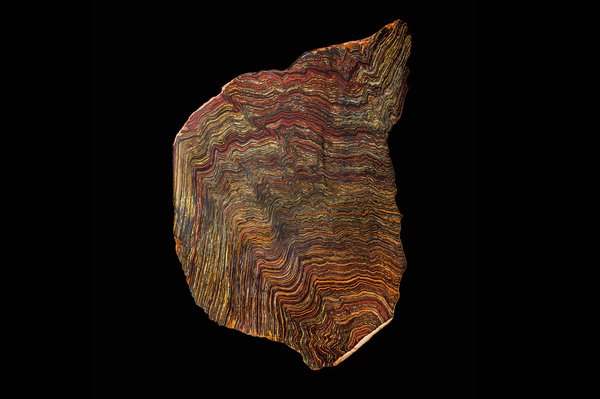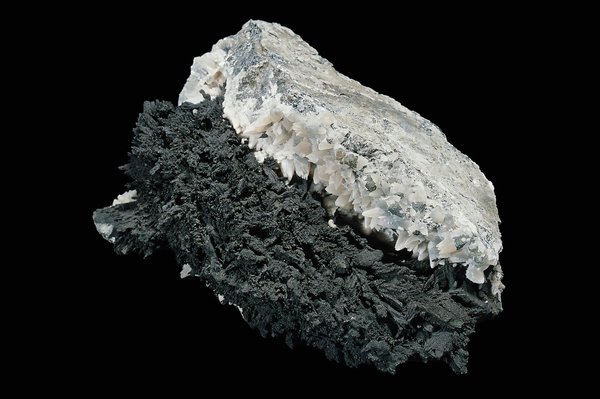Minerals from Australia
The Australian collection is renowned for its mineral diversity, crystal perfection, aesthetic appeal and high Australian content.


Mining in Australia
Mining in Australia stretches back thousands of years. First Nations peoples quarried different types of stone, each with its own value and use. Trade routes were established, particularly for materials with high significance. Traces of over 400 mine sites are found along the east coast alone.
Mining can influence the lives of people and the destinies of nations. It helped shape Australia’s folklore and led to rapid population and industrial growth, particularly during the gold rushes of the 1850s. Mining has also significantly impacted the environment and caused heated debates.
Today, Australia is one of the world’s largest producers of several important ores and minerals, particularly iron ore, bauxite, uranium, lead, zinc and cobalt. Precious stones, especially gold, diamonds and opals, are also major exports.
Copper
In 1842, copper ore was found at Kapunda, starting a ‘copper rush’. By the 1860s, South Australia was known as the 'Copper Kingdom' because it had some of the world’s largest copper mines.
Oxidised zone copper minerals
The image below of a polished rock slab is a tribute to nature’s sublime brush work.
The specimen started out as a copper sulphide mineral in volcanic rock that formed on the seafloor about two billion years ago. Millions of years later, the ore was exposed at the Earth’s surface. Exposure to water, carbon dioxide and oxygen transformed the primary sulphides into a colourful canvas of secondary minerals: blue chrysocolla (copper silicate with water), green malachite (copper carbonate hydroxide) and brown iron oxide-stained jasper (silicon dioxide).
Finally, this stunning specimen was plucked from the ground and preserved as a museum piece rather than mined for its ore. Large slabs like this are becoming very scarce and will soon be unobtainable.

Gold
For thousands of years and in many cultures, gold has been highly prized. We’ve desired it as a symbol of status and for its appearance – often linked to the power of the Sun or the aura of gods – and used it as money and in trade. Today, while many of us still value gold for its beauty, about 40 per cent ends up in electronics and electrical applications.
Gold occurs in its native or ‘free’ form but also forms 22 other minerals in combination with other elements. Although rare, gold can be concentrated in many places and in different rocks. When washed out, this gold gets trapped in sediments by its heavy weight. This is called alluvial gold. Gold can also be carried in silica-rich solutions and then deposited in quartz veins. The larger veins are called reefs.
Australia lays claim to many of the world’s largest gold nuggets.
Most large gold nuggets in Australia were found during the gold rush, but were melted down or processed. Replicas were often cast from originals but could also be impressions made from descriptions, drawings or photos. The Australian Museum has 43 gold nugget replicas, some acquired as long ago as 1883.
Large specimens are still found today, such as the Hand of Faith, found in 1980 and displayed in a Las Vegas casino, and the Normandy Nugget, discovered in 1995 and held at the Perth Mint. These are the largest and second largest nuggets still in existence.
Welcome Stranger
Cornish miners found the largest alluvial 'Welcome Stranger' gold nugget while searching around the roots of a tree at Moliagul, Victoria in February 1869. It was lying only 3cm below the surface and weighed 72kg net! They were paid £9381 (over $3 million today) and the nugget was melted down and sent as ingots to the Bank of England.


Largest gold specimen
Bernard Holtermann, a successful miner and businessman, was partner in a gold mining company at Hill End, NSW. In 1872, they uncovered the largest gold specimen ever found. It was not strictly speaking a nugget, rather a mass of gold embedded in quartz and slate.
Soon after its discovery, the specimen was melted down to extract its gold – a whopping 93.2kg, valued today at about $5.2 million. It made Holtermann a rich man and he built a mansion in Sydney which is now part of Shore Grammar.
Iron
Iron transformed human civilisation and is the most important metal we’ve ever used. The first metals mined, such as gold and copper, were too soft to replace stone tools. When iron became readily available, its use led to revolutions in warfare and agriculture – better tools for weapons and to cultivate land – and eventually to steel machinery and the transformation of industry.
Today, iron accounts for 95 per cent of global metal production, primarily to create steel used in almost every aspect of daily life.
Banded Iron Formation
The stunning slice of rock seen below is made of alternating bands of three minerals: red bands of jasper; golden bands of tiger eye (both silicas); and dark bands of iron oxide (hematite and magnetite). They were once iron-rich and silica-rich sediments that settled on an ancient sea floor 2.7–2.4 billion years ago.
While beautiful, banded iron formations are economically important as they provide most of the iron ore mined today, they also reveal a significant story about Earth’s past.

A time of change
The minerals in this banded iron formation were deposited during a time of dramatic change. Earth’s first atmosphere had no oxygen, the first organisms did not need oxygen to survive, and the oceans contained large amounts of dissolved iron and silicon. Once organisms evolved that could produce oxygen by photosynthesis, such as cyanobacteria, the oxygen in the atmosphere and oceans greatly increased.
As a result, the iron and silicon in the oceans became insoluble. The iron combined with the oxygen to form iron oxide, and silica precipitated. The resulting sediments accumulated in alternating bands on the ocean floors. This process continued for millions of years but no longer happens today.
Opals
About 95 per cent of the world’s opals come from Australia. Places like Lightning Ridge in New South Wales and Coober Pedy in South Australia have become synonymous with opal mining.

Australia’s opal ‘monopoly’ is primarily due to a unique combination of geological conditions and events. Most opals form after water containing dissolved silica fills voids in sedimentary rocks. As the water evaporates from the jelly-like solution, layers or nodules of opal remain. Around 110 million years ago, Australia was covered by a vast inland sea. The sea retreated 10 million years later, creating the perfect conditions for opal formation. Some rare opals also form in metamorphic and volcanic rocks.
Opal is an unusual silica composed of silica spheres and water. It is notorious for being brittle when heated or struck, can absorb impurities from water and change its character when heated. Even body warmth can impact an opal. Despite these, it is still a popular gem.

Gurabaan - Stone
For First Nations Peoples, gurabaan is one of the oldest Ancestors, storing the record of Country in its body. This record encompasses the minerals of the land, waters and skies and the story of how these elements have interacted over millennia.
Quarry sites with appropriate gurabaan are not always local. Mogora (axes), for example, are often made from hard metamorphic rock and there is evidence of its trade over 1000 kilometres.
The core and flake pieces are worked gurabaan for making tools. They speak to the movement that gurabaan makes across country, both through geological process and human movement.
Australian mining regions
- Pilbara Block – Western Australia
The Pilbara is one of the oldest regions on Earth, with rocks as old as four billion years. Some of the world’s largest mines are found here. Sedimentary basins have banded ironstones, formed over 2000 million years, mined on a massive scale. - Yilgarn Block – Western Australia
The Golden Mile of Kalgoorlie-Boulder has been Australia’s largest gold producer since 1898. It has unusual gold minerals – tellurides and solving the problem of their extraction made Kalgoorlie a world leader in gold metallurgy. - Harts Range – Northern Territory
This harsh arid region discouraged mineral exploration until the late 19th century. Australian Museum mineralogists collected fine crystal specimens in the 1930s and 1970s. Some came from metamorphic schists and gneisses, which are around 2000 million years old. - Lachlan Fold Belt – Tasmania
Tasmania lies towards the end of the Lachlan Fold Belt which formed when earth movements crumpled eastern Australia from 450 to 340 million years ago. The metallic sulphide and gossan minerals formed around old volcanic chains, submarine lavas and granites, and in old sea floors now thrust into the fold belt and altered to serpentine rock. - Lachlan Fold Belt – New South Wales and Queensland
Gold diggings, old metal mines and limestone caves are some of the features found in the folded and faulted rocks of the Lachlan Fold Belt. Many of these mines have recently started production again with new ore deposits continuing to be discovered. - Barrier Ranges and Consols Mine – New South Wales
The Barrier Ranges, near Broken Hill, are noted for metamorphic and granite pegmatite minerals such as mica, feldspar, garnet and beryl and many small orebodies. The silver and lead orebodies were mined as early as 1876 before the Broken Hill lodes were discovered in 1883. - Broken Hill – New South Wales
Broken Hill is one of the world’s richest lead-zinc-silver deposits. The huge, 300-million-tonne orebody was discovered in 1883 and the superb mineral specimens attract collectors from around the world. It was born on the ocean floor about 1800 million years ago, from metal-rich hot springs. Our Museum has one of the best collections of Broken Hill minerals in the world; they are part of Australia’s mining and scientific heritage. - Granite belt – eastern Australia
Granite landscapes are easily recognised from their massive, rounded boulders. Granite bodies cooled in the hearts of folded mountain ranges and late-stage metal-bearing fluids deposited minerals in and around them. Erosion exposed mineral deposits in these granites. - Far North Australia
Early mineral exploration in the tropical north was hindered by appalling conditions of heat, humidity and isolation, but eventually revealed many deposits of copper, lead, zinc and uranium minerals. The Kimberley region , named after Kimberley in South Africa, is home to one of the world’s largest diamond deposit and the Argyle Diamond Mine. - Flinders Ranges and Olary – South Australia
Rocks in the Flinders Ranges were originally laid down from about 800 million years ago as sediments in a large basin. They have been folded, faulted, metamorphosed and uplifted. The Olary region has gold, copper, lead and uranium deposits, some containing extremely rare minerals. - Copper belt – South Australia
Australia’s earliest European mining was in South Australia. The first metal mine, at Glen Osmond near Adelaide, produced lead ore in 1841, but was overshadowed by the discovery of copper ores in 1842. By the 1860s, South Australia had some of the world’s largest copper mines. The mines also produced superb crystals of colourful copper minerals, the best examples of which are now preserved in museums. - Victoria
Although famous for its gold discoveries, Victoria also produces a great variety of zeolite minerals found in basalt rocks formed during volcanic eruptions. Many of the early basalt ‘bluestone’ quarries were in suburbs of Melbourne, such as Burnley, Richmond and Collingwood.





